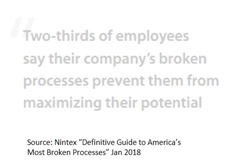Müll rein, Müll raus: Automatisieren Sie keine fehlerhaften Prozesse

Als ich noch ein kleines Mädchen war und mich darauf vorbereitete, die allererste internetfähige Application für mein Unternehmen auszuliefern, habe ich eine wertvolle Lektion gelernt. Es ging nicht um Technologie. Es ging nicht um das Internet. Es ging um Prozesse und wie frustrierend sie für die Menschen sein können, die sich in ihnen zurechtfinden müssen.
Alles was wir brauchten, war eine einfache Firewall-Regel, um den Datenverkehr zur Application zuzulassen. Das ist es. Eine Regel.
Die Änderung selbst dauerte für den Netzwerktechniker wahrscheinlich ganze fünf Minuten, um sich anzumelden, den Befehl einzugeben und die Konfiguration zu speichern. Der Vorgang selbst dauerte jedoch Wochen.
Dies liegt daran, dass der Vorgang (1) nicht dokumentiert war und (2) nicht weniger als drei verschiedene Unterschriften auf einem ausgedruckten Genehmigungsformular erforderte. Unterschriften, die auf jemandes Schreibtisch vergraben auf das Ende des Urlaubs und ihre Wiederentdeckung warteten.
Schließlich bekamen wir die Genehmigungen und die Änderungen wurden vorgenommen und voilà! Ich bekam eine schöne Plakette und einen Klaps auf die Schulter.
Spulen wir viele Jahre vor, werden wir feststellen, dass Prozesse immer noch eine erhebliche Quelle der Angst für die Mitarbeiter darstellen. Eine aktuelle Umfrage von Nintex befasste sich mit dieser Frustration und fand heraus, dass Prozesse in vielen Unternehmen tatsächlich die Ursache für Unzufriedenheit und sogar Mitarbeiterfluktuation sind.
Tatsächlich gaben 72 % der Mitarbeiter, die gerade nach einem neuen Arbeitgeber suchen, an, dass die IT-Prozesse nicht funktionierten. Im Vergleich dazu stimmten nur 58 % der gesamten Mitarbeiter dieser Aussage zu. Als weitere problematisch wurden das Drucken (ja, Drucken) sowie Verwaltungsvorgänge wie Gehaltserhöhungs- und Beförderungsvorgänge genannt.
Insgesamt hat Nintex die „Fehlerbehebung bei der Technologie“ und den „Zugriff auf Tools und Dokumente, die eine gute Arbeitsleistung ermöglichen“ als die beiden am häufigsten fehlerhaften Prozesse in der amerikanischen Wirtschaft identifiziert. Der Bericht stellt außerdem fest, dass „das Fehlen eines zeitnahen IT-Services die Mitarbeiter unmittelbar dazu verleitet, Schatten-IT zu betreiben – eine Praxis, die Unternehmensdaten zwangsläufig einem Risiko aussetzt.“ Tatsächlich geben 40 Prozent der Befragten an, dass sie als direkte Folge ungelöster IT-Probleme nicht genehmigte Geräte oder Apps verwendet haben.“
Sie erinnern sich vielleicht an unsere eigene Untersuchung, in der eine ähnliche Reaktion von DevOps auf Frustrationen hinsichtlich der Produktionspipeline-Prozesse festgestellt wurde. Im Rahmen dieser Untersuchung erfuhren wir, dass mehr als ein Viertel (27 %) der DevOps-Teilnehmer angab, dass der fehlende Selfservice-Zugriff auf Produktionspipelines durch Automatisierung ihre Entscheidung, auf Cloud-basierte Lösungen zurückzugreifen, „stark“ und bei 38 % „etwas“ beeinflusst.
Prozesse sind sowohl für den geschäftlichen als auch für den betrieblichen Erfolg von großer Bedeutung.

Sie sind im Kontext der digitale Transformation sogar noch wichtiger, bei deren Hilfe diese Prozesse teilweise kodifiziert (automatisiert) werden sollen, um Produktivitäts- und Effizienzsteigerungen zu erzielen.
Der Bericht von Nintex ist hilfreich bei der Analyse unserer eigenen Ergebnisse aus dem State of Application Delivery 2018, in dem die Vorteile untersucht werden, die sich Unternehmen von ihren Bemühungen zur digitale Transformation erwarten (wünschen).
Ganz oben auf dieser Liste stand die IT- Optimierung . Auf Platz drei landete die Geschäftsprozessoptimierung .
Erkennen Sie ein Thema?
Viele Unternehmen investieren in die digitale Transformation, um ihre Effizienz deutlich zu steigern. Optimierung bedeutet genau das: eine Situation oder Ressource bestmöglich und effektiv zu nutzen.
Das ist übrigens die Wörterbuchdefinition. Das habe ich mir nicht ausgedacht.
Bei der Optimierung geht es darum, dass man zunächst den Prozess verstehen muss. Sie müssen es darlegen – ob es sich dabei nun um die Anforderung einer neuen virtuelle Maschine oder Container-Umgebung, das Drucken eines Dokuments oder das Einreichen eines Antrags auf eine Auszeit handelt.
Erst wenn Sie den Prozess jetzt kennen, können Sie mit der Optimierung beginnen. Und das sollten Sie unbedingt versuchen, bevor Sie es in einem Business Process Management (BPM)-System oder in Skripten und Vorlagen kodifizieren, die den Prozess für Sie ausführen.
Denn „Garbage in, Garbage out“ ist nicht nur der Kommentar eines Entwicklers zu Daten oder Code. Dies gilt für alle Prozesse. Wenn Sie einen schlechten Prozess automatisieren, werden Sie schlechte Ergebnisse erzielen – nur schneller, als wenn Sie ihn manuell ausgeführt hätten.
Für die Optimierung – sei es von IT- oder Geschäftsprozessen – ist zunächst ein Verständnis dafür erforderlich, was Sie optimieren möchten. Sie müssen den Wertstrom abbilden – die einzelnen Aufgaben, aus denen sich ein Geschäftsvorgang zusammensetzt – und den überflüssigen Ballast loswerden, der keinem wirklichen geschäftlichen oder betrieblichen Zweck dient, außer: „Das haben wir schon immer so gemacht.“
Und solche unnötigen Schritte gibt es auch in IT-Prozessen. Eine Zustimmung die nicht nötig ist. Warten auf eine Aufgabe, die keine blockierende Abhängigkeit ist. Die Automatisierung als Teil Ihrer internen Bemühungen zur digitale Transformation wird die notwendigen technischen Schritte zur Erfüllung einer Anfrage nicht radikal verändern. Aber es kann die Betriebsabläufe radikal verändern, indem es eine ganze Reihe von Ineffizienzen und unnötigen Wartezeiten aufdeckt, die beseitigt werden können.
Bei der Optimierung geht es zwar darum, die IT und das Geschäft schneller zu machen, doch zunächst einmal geht es darum, die IT und das Geschäft intelligenter zu machen.
